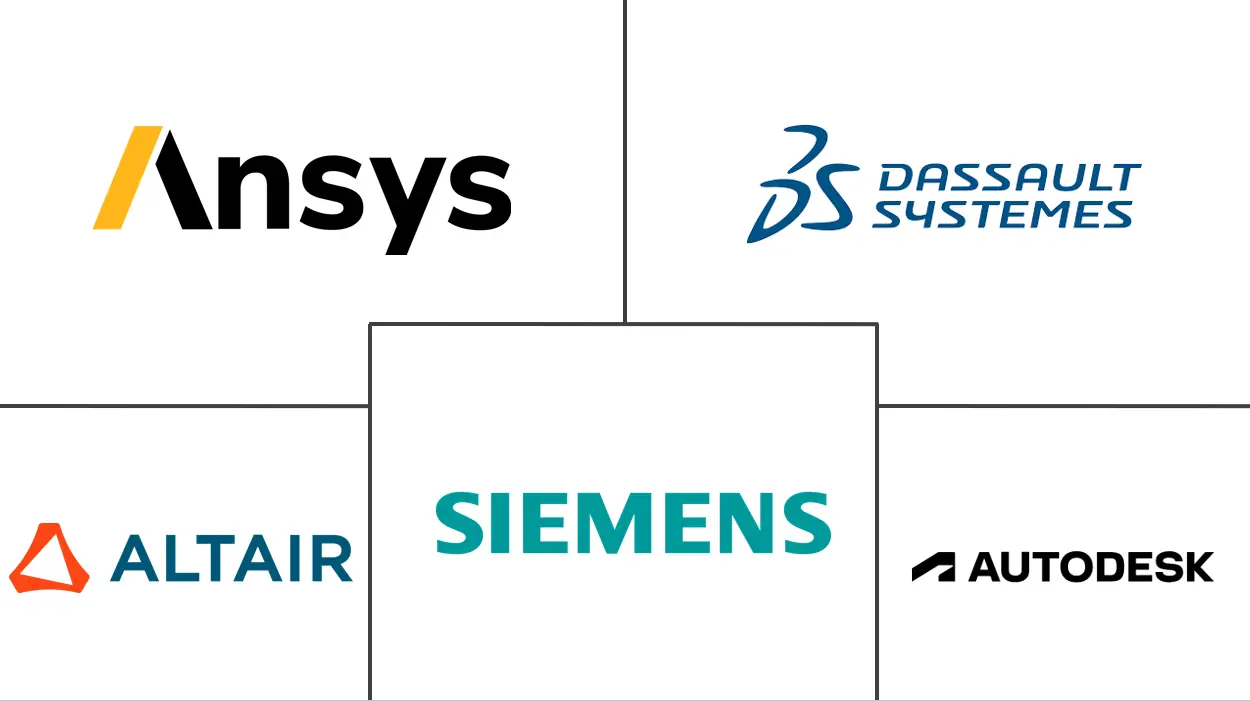Computer Aided Engineering Market Size and Share
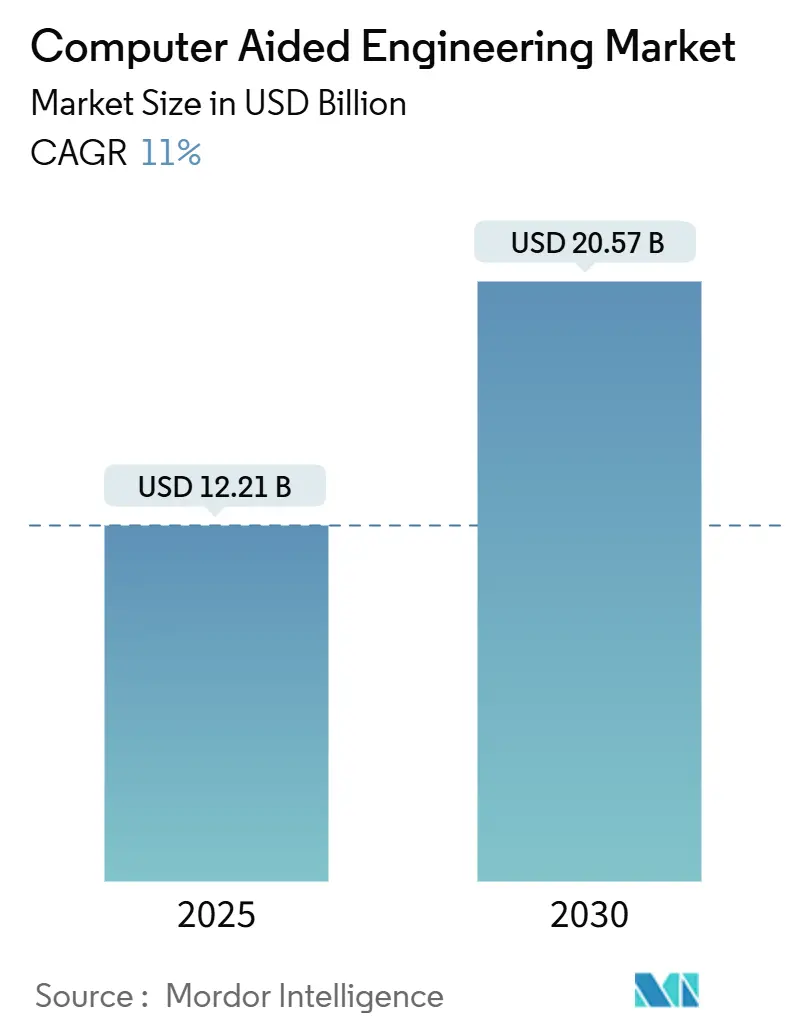
Computer Aided Engineering Market Analysis by Mordor Intelligence
The computer aided engineering market size is valued at USD 12.21 billion in 2025 and is projected to expand to USD 20.57 billion by 2030, registering an 11.00% CAGR. High-performance cloud infrastructure, AI-assisted solvers, and stricter regulatory expectations for virtual prototyping are accelerating adoption across product-development lifecycles. Companies are replacing late-stage physical testing with early-stage multiphysics simulation to meet tighter launch windows and embedded sustainability targets. Asia’s leadership, sustained by large-scale semiconductor investments and rising automotive electrification, underpins global momentum. Software licences remain the principal revenue generator, yet advisory and integration services are surging as enterprises struggle to keep pace with the skills required for increasingly complex digital-twin environments.
Key Report Takeaways
- By component, software captured 73.5% of the computer aided engineering market share in 2024, while services are on track for a 12.83% CAGR to 2030.
- By software type, finite element analysis led with 35.75% computer aided engineering market share in 2024; computational fluid dynamics is forecast to advance at 12.03% CAGR through 2030.
- By deployment, on-premise retained 79% share of the computer aided engineering market in 2024, whereas cloud-based solutions are expected to grow at a 13.97% CAGR between 2025-2030.
- By organisation size, large enterprises held 67.67% of the computer aided engineering market in 2024; small and medium enterprises are projected to expand at an 11.80% CAGR.
- By end-user vertical, automotive commanded 28.5% of the computer aided engineering market size in 2024, while healthcare is projected to rise at a 12.15% CAGR.
- By geography, Asia accounted for 38.5% of the computer aided engineering market in 2024 and maintains the fastest absolute revenue expansion to 2030.
Global Computer Aided Engineering Market Trends and Insights
Drivers Impact Analysis
| Driver | (~) % Impact on CAGR Forecast | Geographic Relevance | Impact Timeline |
|---|---|---|---|
| Integration of AI/ML-Driven Generative Design for EV Lightweighting in EU & China | +2.8% | Europe, China, North America | Medium term (2-4 years) |
| Regulatory Push for Virtual Prototyping in Aerospace (FAA/EASA) | +1.9% | North America, Europe | Short term (≤ 2 years) |
| Cloud-Native HPC Access Fuelling SME Adoption in Asia | +2.1% | Asia, particularly India, Japan, South Korea | Medium term (2-4 years) |
| Sub-5 nm Semiconductor Thermal Challenges Requiring Multiphysics CFD | +1.7% | Global, with concentration in East Asia, North America | Short term (≤ 2 years) |
| Sustainability-Led Digital Twins for Energy Optimisation in Middle East Refineries | +1.4% | Middle East, North America | Medium term (2-4 years) |
| Defence Modernisation (Hypersonics) Driving FSI Simulations in US & Australia | +1.6% | North America, Australia, Europe | Long term (≥ 4 years) |
| Source: Mordor Intelligence | |||
AI/ML-Driven Generative Design for EV Lightweighting in EU & China
Automakers are coupling generative algorithms with finite-element solvers to reduce curb weight without sacrificing crashworthiness. MeshWorks shows development-time cuts of up to 70% for battery modules, letting engineers test previously impractical topologies.[1]Radha Krishnan, “DEP MeshWorks: Pioneering CAE Innovations for EVs,” eletimes.comStudies demonstrate 10% mass reductions translating into 6–8% energy-consumption improvements—vital in markets pushing aggressive zero-emission mandates. The impact is magnified in Europe and China, where subsidy structures and fleet-average CO₂ targets make lightweight architectures a competitive requirement. Suppliers integrating AI-ready simulation templates expect shorter homologation cycles and better utilisation of multi-disciplinary teams.
Regulatory Push for Virtual Prototyping in Aerospace (FAA/EASA)
The FAA’s 2024 powered-lift aircraft rule recognises simulation data for certification evidence, shrinking costly full-scale tests.[2]Federal Aviation Administration, “Integration of Powered-Lift Aircraft,” federalregister.gov Parallel initiatives at EASA encourage digital engineering to accelerate propulsion and structure approvals. Hardware-software platforms such as the Millennium M1 CFD Supercomputer compress multi-week aero-thermal studies into hours, aligning engineering throughput with tighter programme timetables. The result is lower non-recurring expenditure and faster entry into service across both commercial and defence segments.
Cloud-Native HPC Access Fuelling SME Adoption in Asia
Pay-per-use clusters are dismantling the capital barrier historically faced by smaller manufacturers. India’s National Supercomputing Mission expanded capacity to 32 petaflops and rolled out innovation hubs that provide subsidised cycles for qualified start-ups.[3]Department of Science & Technology, “Annual Report 2024-25,” dst.gov.inSimilar programmes in Japan and South Korea anchor regional ecosystems around automotive and electronics supply chains. Annualised cloud uptake outpaces the overall computer-aided engineering market by nearly three percentage points, signalling durable penetration among first-time simulation users.
Sub-5 nm Semiconductor Thermal Challenges Requiring Multiphysics CFD
Densities beyond 150 million transistors/mm² create localised hotspots that traditional package-level assumptions miss. Electronics Cooling reports that optimised flow restrictors lower dielectric-fluid maldistribution and cut rack power costs. The Semiconductor Research Corporation’s MAPT roadmap tags thermal-mechanical co-analysis as a strategic enabler for advanced packaging.[4]SRC, “MAPT Roadmap 2023,” srcmapt.orgVendors integrating electrical, thermal, and structural solvers into a single workflow gain first-mover advantage as foundries demand validated IP blocks before tape-out.
Restraints Impact Analysis
| Restraint | (~) % Impact on CAGR Forecast | Geographic Relevance | Impact Timeline |
|---|---|---|---|
| Pay-per-Use Cloud Licensing Uncertainty for Tier-2 Auto Suppliers | -1.2% | Global, with emphasis on emerging markets | Short term (≤ 2 years) |
| Validation Gaps in Bio-mechanical Models Limiting Surgical Device Uptake | -0.9% | North America, Europe, Advanced Asian markets | Medium term (2-4 years) |
| Export-Control Curbs on HPC Chips Capping Simulation Scale in China | -1.1% | China, with spillover effects in Asia | Medium term (2-4 years) |
| Steep Learning Curve for Multiphysics Coupling in India | -0.8% | India, Southeast Asia | Short term (≤ 2 years) |
| Source: Mordor Intelligence | |||
Pay-per-Use Cloud Licensing Uncertainty for Tier-2 Auto Suppliers
Variable billing creates planning risk for parts makers whose simulation demand peaks late in OEM programme cycles. Academic reviews show SMEs lag larger peers in predictive-analytics uptake because of resource constraints and cost opacity. Until vendors standardise subscription tiers or introduce consumption caps, smaller firms may delay full migration, tempering overall computer aided engineering market expansion.
Validation Gaps in Bio-mechanical Models Limiting Surgical Device Uptake
Finite-element representations of heterogeneous tissues still struggle with inter-patient variability. Mandibular reconstruction research shows stress reductions hinge on gap-minimisation assumptions that differ case by case. Friction-coefficient sensitivity in orthopaedic implants accounts for up to 13% output variance. Regulatory agencies now seek Good Simulation Practices to tighten model credibility. Without broader validation datasets, device makers face elongated approval cycles, muting near-term growth in healthcare simulation.
Segment Analysis
By Component: Software Dominates, Services Accelerate
The software segment contributed 73.5% of 2024 revenue, reflecting its centrality to solver innovation and interface upgrades that underpin the computer-aided engineering market. Ansys’ 2024 R1 release rolled out modular workspaces and AI-ready data pipelines, illustrating steady investment in workflow productivity. Expanded physics libraries and GPU acceleration lock in entrenched licence renewals, even as newer entrants chip away in specialist niches. Services, though smaller, are scaling faster at 12.83% CAGR as enterprises confront knowledge gaps in multiphysics, cloud orchestration, and AI model training.
Rising complexity is widening the divide between standard out-of-the-box deployment and best-practice adoption. Advisory firms now bundle domain-specific templates—such as battery thermal run-away analyses—streamlining project kick-offs. This consultative layer is particularly valuable to organisations transitioning from legacy finite-element tools to integrated digital-twin platforms. Consequently, services revenue is capturing a larger portion of total computer aided engineering market size, especially within emerging economies where in-house expertise remains scarce.
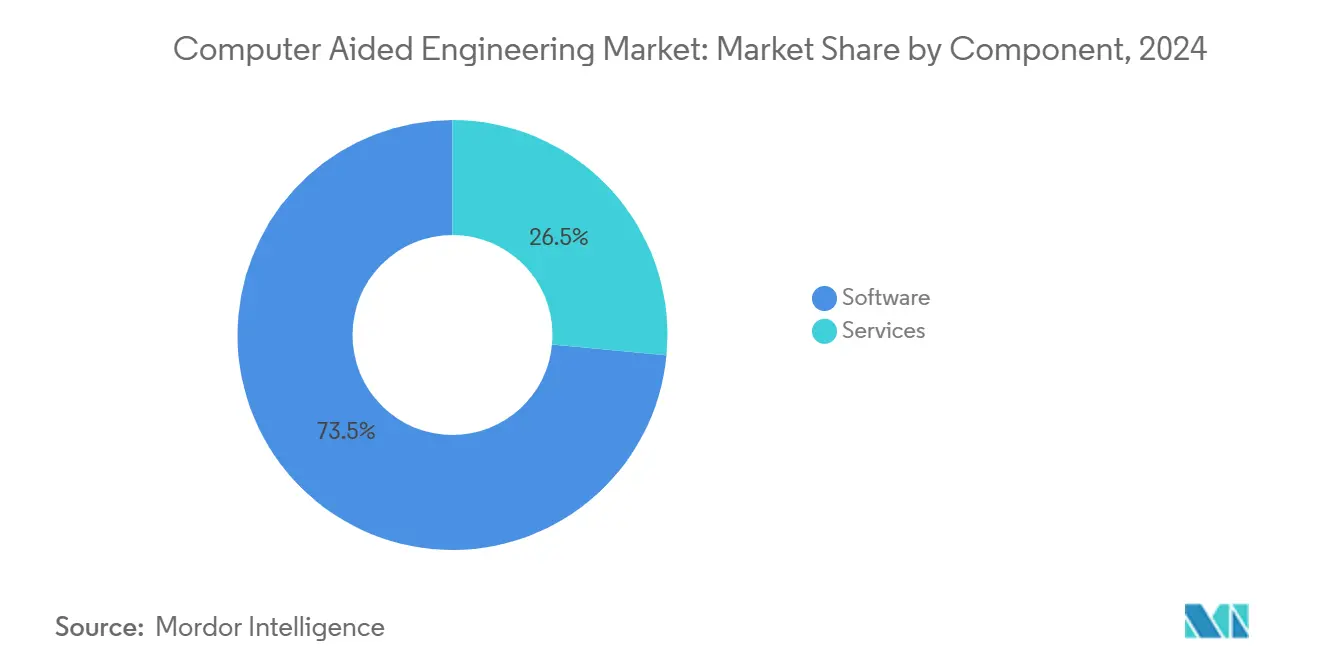
By Software Type: FEA Leads, CFD Accelerates
Finite element analysis accounted for 35.75% of the 2024 computer-aided engineering market share, sustained by broad applicability across structural, thermal, and electromagnetic problems. Continuous improvements in mesh automation and material models enable faster convergence for high-fidelity assemblies. Generative design overlays now exploit topology-optimised lattices to reduce metal volumes in aircraft brackets, achieving double-digit weight savings.
Computational fluid dynamics is the fastest-growing category at 12.03% CAGR as electronics thermal bottlenecks and aerodynamic optimisation converge. Cadence’s GPU-based Millennium M1 supercomputer demonstrates order-of-magnitude speed-ups for unsteady flow simulations, unlocking high-resolution studies within design-cycle windows. As AI frameworks predict flowfields with sparse CFD training sets, vendors anticipate broader uptake in process industries and renewable-energy design.
By Deployment: Cloud-Based Solutions Gain Momentum
On-premise deployments retained 79% revenue in 2024, reflecting historic investment in local clusters for IP-sensitive workflows. Defence contractors and tier-one automakers still prefer deterministic performance and data-sovereignty control offered by owned infrastructure. However, cloud subscriptions are forecast to outpace overall computer-aided engineering market growth at 13.97% CAGR. Recent releases embed cloud-native job scheduling, encrypted data vaults, and interactive collaboration canvases, minimising migration friction. Flexible scaling is particularly attractive to engineering teams handling episodic simulation spikes linked to new-model launches.
Financial agility resonates with SMEs entering the simulation arena for the first time. Pay-as-you-go clusters allow proof-of-concept runs without multimillion-dollar capital outlays, fostering pilot adoption that often matures into hybrid environments. Consequently, cloud deployment is seeding incremental revenue streams from customer segments historically beyond the reach of premium CAE licensing.
By Organisation Size: Large Enterprises Lead, SMEs Catch Up
Large enterprises commanded 67.67% of 2024 revenue, leveraging multidisciplinary CAE teams and devoted IT budgets to run parallel optimisation loops across mechanics, fluids, and electromagnetics. Integration with lifecycle platforms such as PLM and MES enables traceable design decisions, reinforcing simulation as an enterprise-wide competency.
SMEs are forecast to gain share through 2030, growing at 11.80% CAGR as simplified UIs, templated studies, and managed-service models lower adoption barriers. Government compute grants in Europe and Asia further subsidise access. Vendors offering starter bundles that pair cloud credits with on-demand mentorship are successfully courting first-time users, expanding the total addressable computer-aided engineering market size without cannibalising enterprise renewals.
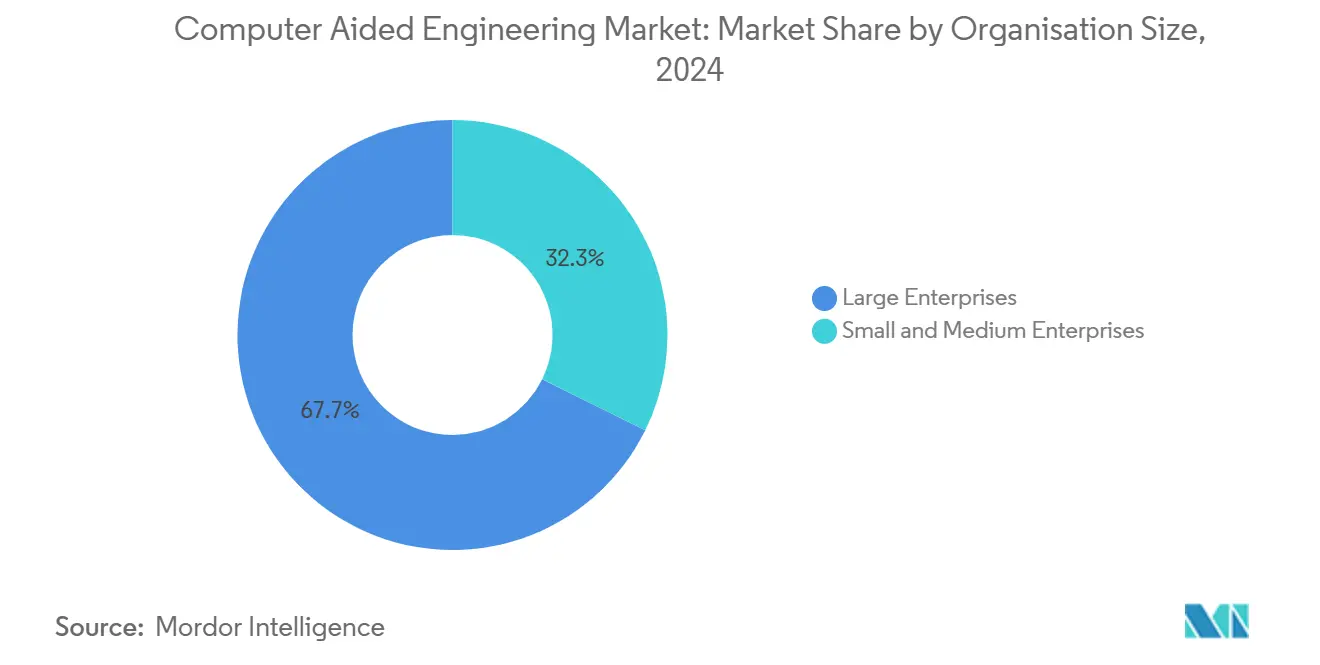
By End-User Vertical: Automotive Dominates, Healthcare Rises
Automotive represented 28.5% of 2024 revenue. Electrification and autonomous-driving programmes intensify simulation demand from battery safety to sensor thermal stability. MeshWorks’ rapid parametrisation slashes CAE turnaround by up to 70%, enabling design studios to explore lightweight topologies earlier in vehicle programmes.
Healthcare, though smaller, is the fastest-growing vertical at 12.15% CAGR as device makers harness patient-specific modelling to predict implant performance. Regulatory bodies increasingly recognise in-silico evidence, allowing partial substitution of animal or cadaver testing. Aerospace and defence maintain robust investment given hypersonic and urban-air-mobility initiatives that demand tightly coupled fluid-structure interaction studies supported by state funding calls.
Geography Analysis
Asia led with 38.5% of 2024 revenue, buoyed by semiconductor expansion and state-backed manufacturing digitalisation. China’s drive for self-reliance spurred breakthroughs such as LICOMK++ ocean modelling, underscoring domestic HPC capability growth scmp.com. India’s National Supercomputing Mission and South Korea’s fab investments further support a double-digit regional CAGR. The region’s outsized electronics supply chain keeps multiphysics CFD licences in sustained demand.
North America ranked second, dominated by the United States' activity in defence modernisation and aerospace digital twins. Federal incentives for clean-energy infrastructure amplify demand for structural and thermal simulation in wind-turbine and grid-storage projects. Cloud-hyperscaler proximity affords users elastic compute headroom, accelerating AI integration within day-to-day workflows.
Europe retains strong footholds in automotive and commercial aviation simulation. Clean-Aviation funding for hydrogen propulsion and ultra-efficient airframes steers budgets toward next-generation CFD and composite-model solvers. Regulations mandating lifecycle carbon accounting motivate digital-twin rollouts for predictive maintenance and fuel-burn optimisation. Meanwhile, the Middle East posts the highest regional CAGR at 12.50% as refiners deploy energy-optimisation twins that cut unplanned downtime by 35%.
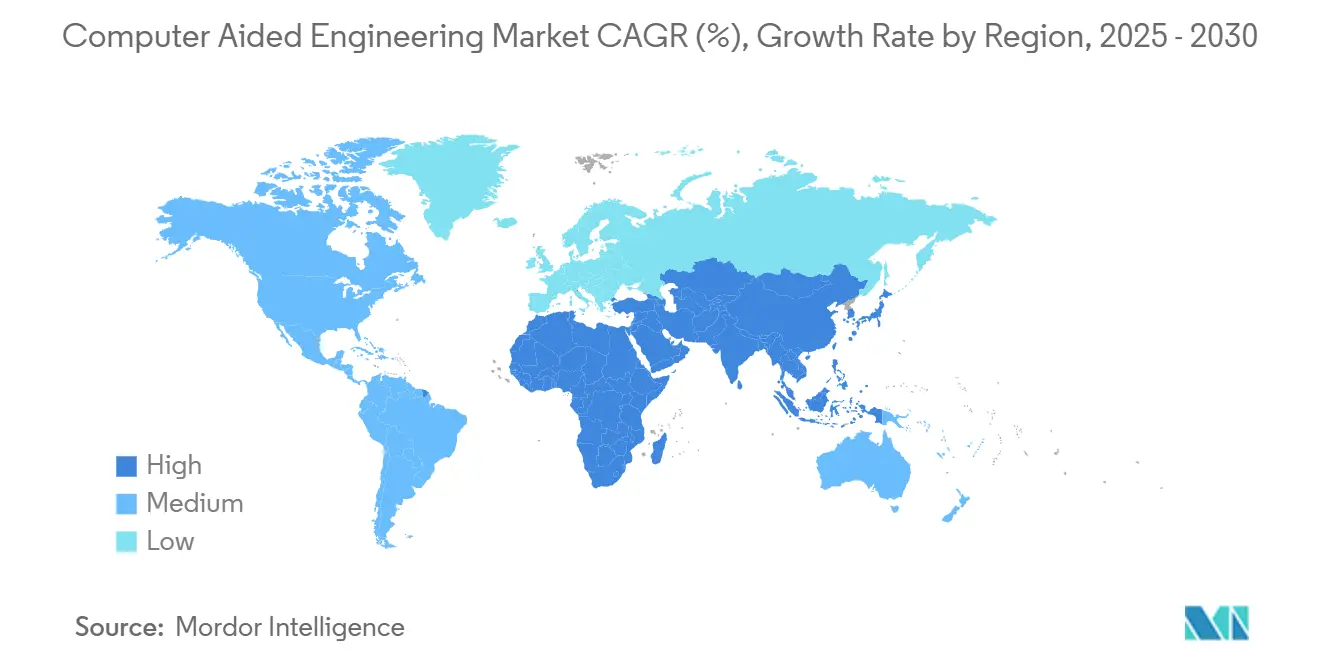
Competitive Landscape
The market is moderately concentrated. Ansys, Siemens, Cadence, Altair, and Dassault Systèmes together account for just over 60% of global revenue. Siemens’ USD 10 billion purchase of Altair in 2024 stitched complementary AI-powered solvers into its digital-twin stack, targeting cross-selling synergies exceeding USD 1 billion a year. Synopsys’ planned 2025 acquisition of Ansys signals further convergence between the EDA and CAE domains, promising integrated chip-to-system optimisation workflows.
Competitive intensity clusters around three axes: physics-informed AI, cloud delivery, and verticalised pre-sets. Altair’s physicsAI accelerates field prediction 1,000× versus conventional solvers, while Cadence bundles hardware and software in the Millennium M1 to lock users into an end-to-end ecosystem. New entrants target white spaces in additive manufacturing, composite micro-mechanics, and battery degradation modelling. Strategic alliances between CAE vendors and cloud hyperscalers aim to embed turnkey HPC capacity in subscription bundles, further lowering switching costs.
Customer stickiness remains high due to solver familiarity, model validation history, and workflow integration with PLM and version-control systems. Nonetheless, pricing scrutiny among mid-tier suppliers is spawning interest in open-source meshing and pay-per-solve platforms. Vendors that couple consumption-based billing with transparent cost dashboards are best positioned to defend share within the growing cloud segment.
Computer Aided Engineering Industry Leaders
-
ANSYS, Inc
-
Dassault Systemes
-
Siemens Digital Industries Software (Siemens)
-
Altair Engineering Inc.
-
Autodesk Inc.
- *Disclaimer: Major Players sorted in no particular order
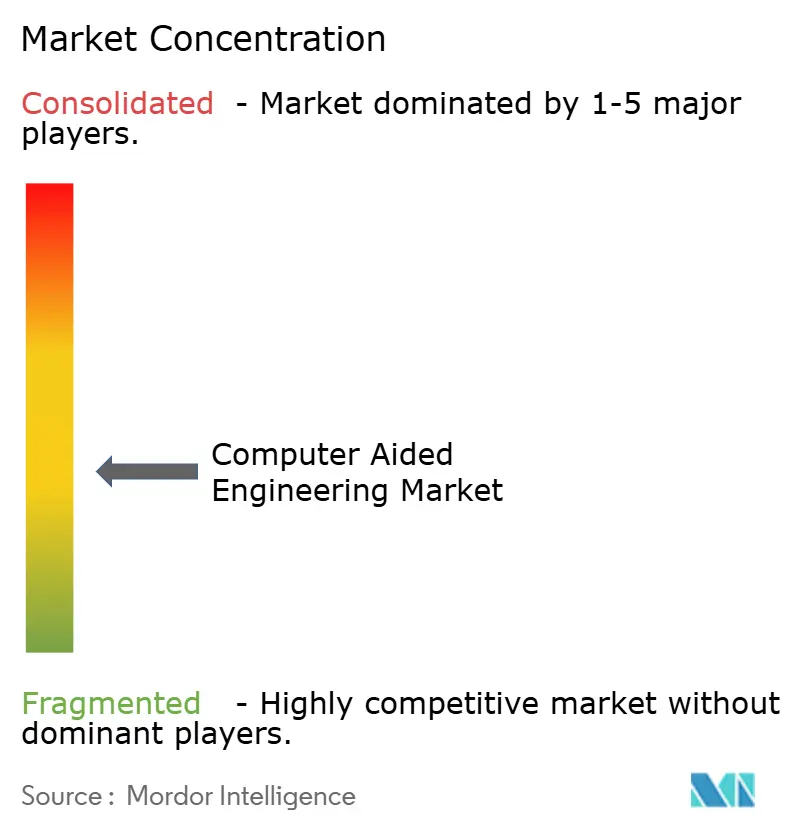
Recent Industry Developments
- May 2025: Siemens completed the Altair acquisition for roughly USD 10 billion, integrating Altair’s generative-design and Multiphysics portfolio into its Xcelerator ecosystem and projecting USD 1 billion long-term revenue synergies.
- April 2025: Ansys released 2025 R1, adding model-prep automation and elastic-cloud scaling that allows thousands of simulation runs within minutes, dramatically reducing physical prototype spend.
- March 2025: The U.S. Commerce Department placed 80 entities on the BIS Entity List, restricting advanced AI and computing exports and capping top-end HPC capacity in certain regions, indirectly influencing CAE compute supply.
- February 2025: Cadence unveiled the Millennium M1 CFD Supercomputer, a GPU-centric system that slashes turnaround for aero-thermal digital twins from weeks to hours.
Global Computer Aided Engineering Market Report Scope
Computer-Aided Engineering (CAE) employs software tools to simulate, analyze, and enhance the performance of products or systems. This approach enables engineers to virtually test and refine designs prior to constructing physical prototypes. It is widely used across various end-use industries to enhance product quality, reduce development costs and speed up time to market. By providing insights into factors like structural integrity, fluid behaviour and thermal performance, CAE enables informed decision-making during the design process.
The study tracks the revenue generated from the sale of computer-aided engineering products and services by various companies worldwide. It also tracks the key market parameters, underlying growth influencers, and major manufacturers operating in the industry, which supports the market estimations and growth rates over the forecast period. The study further analyses the overall impact of macroeconomic factors on the market. The report’s scope encompasses market sizing and forecasts for the various market segments.
The computer-aided engineering market is segmented by software type (finite element analysis, computational fluid dynamics, multibody dynamics, and optimization and simulation), by deployment (on-premise, and cloud based), by end user vertical (automotive, aerospace and defense, electronics and electrical, industrial equipment, healthcare, energy and utilities, and others) and by geography (North America, Europe, Asia-Pacific, Latin America, and Middle East and Africa). The market sizes and forecasts are provided in terms of value (USD) for all the above segments.
| Software |
| Services |
| Finite Element Analysis |
| Computational Fluid Dynamics |
| Multibody Dynamics |
| Optimisation and Simulation |
| On-Premise |
| Cloud-Based |
| Large Enterprises |
| Small and Medium Enterprises |
| Automotive |
| Aerospace and Defence |
| Electronics and Electrical |
| Industrial Equipment |
| Healthcare |
| Energy and Utilities |
| Others |
| North America | United States |
| Canada | |
| Mexico | |
| South America | Brazil |
| Rest of South America | |
| Europe | Germany |
| United Kingdom | |
| France | |
| Italy | |
| Spain | |
| Rest of Europe | |
| APAC | China |
| Japan | |
| India | |
| South Korea | |
| South-East Asia | |
| Australia and New Zealand | |
| Rest of APAC | |
| Middle East and Africa | Saudi Arabia |
| United Arab Emirates | |
| Turkey | |
| South Africa | |
| Rest of Middle East and Africa |
| By Component | Software | |
| Services | ||
| By Software Type | Finite Element Analysis | |
| Computational Fluid Dynamics | ||
| Multibody Dynamics | ||
| Optimisation and Simulation | ||
| By Deployment | On-Premise | |
| Cloud-Based | ||
| By Organisation Size | Large Enterprises | |
| Small and Medium Enterprises | ||
| By End-User Vertical | Automotive | |
| Aerospace and Defence | ||
| Electronics and Electrical | ||
| Industrial Equipment | ||
| Healthcare | ||
| Energy and Utilities | ||
| Others | ||
| By Geography | North America | United States |
| Canada | ||
| Mexico | ||
| South America | Brazil | |
| Rest of South America | ||
| Europe | Germany | |
| United Kingdom | ||
| France | ||
| Italy | ||
| Spain | ||
| Rest of Europe | ||
| APAC | China | |
| Japan | ||
| India | ||
| South Korea | ||
| South-East Asia | ||
| Australia and New Zealand | ||
| Rest of APAC | ||
| Middle East and Africa | Saudi Arabia | |
| United Arab Emirates | ||
| Turkey | ||
| South Africa | ||
| Rest of Middle East and Africa | ||
Key Questions Answered in the Report
How big is the Computer Aided Engineering Market?
The Computer Aided Engineering Market size is expected to reach USD 12.21 billion in 2025 and grow at a CAGR of 11% to reach USD 20.57 billion by 2030.
What is the current size of the computer aided engineering market?
The market is worth USD 12.2 billion in 2025
How fast is the computer aided engineering market expected to grow?
It is forecast to expand at an 11% CAGR, reaching USD 20.6 billion by 2030.
Which component generates most revenue?
Software accounts for 73.5% of 2024 revenue.
Why is cloud-based CAE deployment growing?
Pay-as-you-go HPC capacity and collaboration features drive a projected 13.97% CAGR to 2030.
Which vertical will grow the fastest through 2030?
Healthcare is projected to lead with a 12.15% CAGR as personalised medicine boosts simulation demand.
How concentrated is vendor competition?
The five largest suppliers capture roughly three-fifths of revenue, indicating moderate concentration.
Page last updated on:
